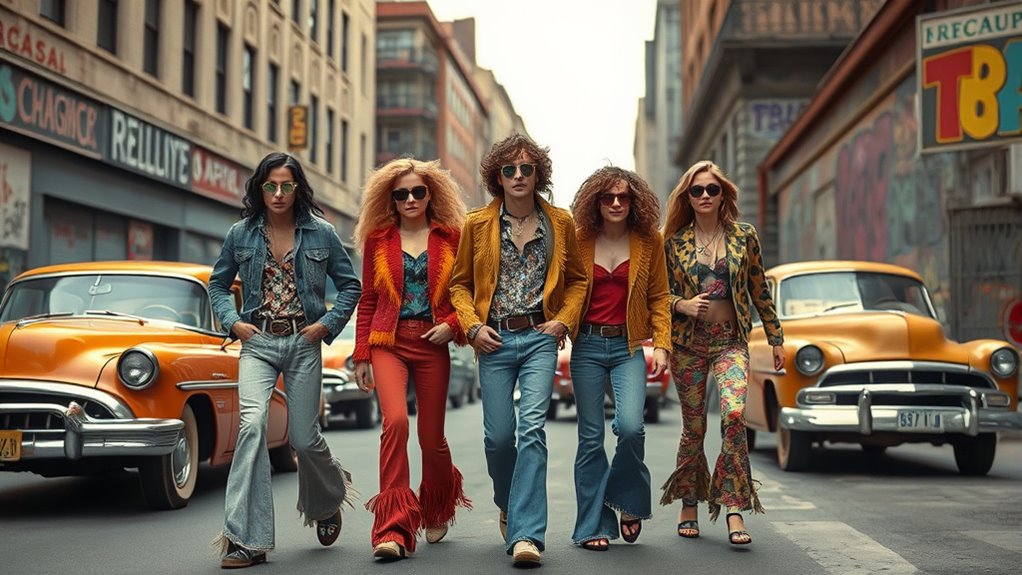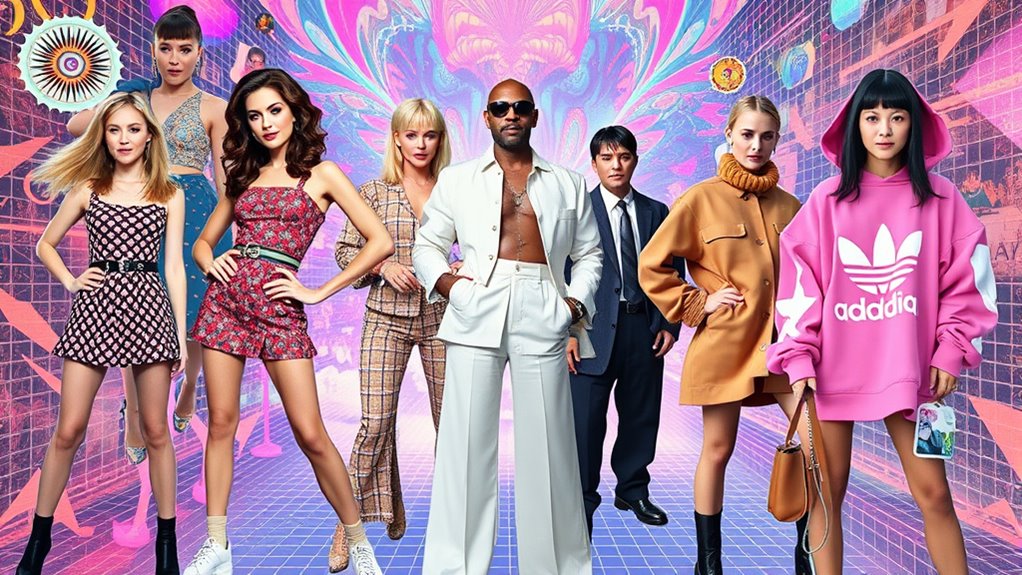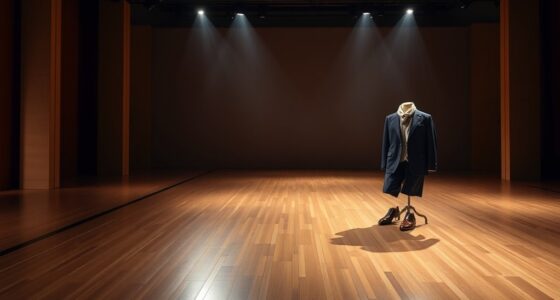Fashion icons across decades have deeply influenced culture by shaping beauty standards, challenging norms, and inspiring new trends. Hollywood stars like Marilyn Monroe and Audrey Hepburn set glamour benchmarks, while rebellious figures of the 1960s and punk musicians broke traditional rules with bold styles. Today’s influencers push boundaries with digital innovation and inclusivity. Their evolving looks reflect societal shifts, making fashion a powerful tool for identity and change. Stay curious to uncover more about how these icons continue to shape our world.
Key Takeaways
- Hollywood stars like Marilyn Monroe and Audrey Hepburn set timeless beauty standards and shaped global fashion trends during the Golden Age.
- 1960s icons such as mods and hippies challenged traditional styles, promoting self-expression and influencing youth culture and rebellion.
- Punk and rock musicians used DIY fashion to symbolize anti-establishment attitudes, transforming everyday clothing into symbols of individuality and protest.
- The power suit emerged as a symbol of female empowerment, challenging gender roles and inspiring societal shifts toward gender equality.
- Modern fashion icons, amplified by social media, influence contemporary culture through trends that emphasize diversity, sustainability, and technological integration.
The Golden Age of Hollywood and the Rise of Glamour

Have you ever wondered how Hollywood stars became the ultimate symbols of glamour? During the Golden Age of Hollywood, stars like Marilyn Monroe, Audrey Hepburn, and Clark Gable transformed movie sets into fashion runways. They set trends with their elegant gowns, tailored suits, and iconic accessories, making style a essential part of their identities. Hollywood’s studio system carefully crafted their images, emphasizing sophistication and allure. Every appearance was meticulously styled to captivate audiences and create fantasies. Their influence extended beyond the screen, shaping beauty standards and inspiring designers worldwide. This era established the star as a cultural icon, turning Hollywood into the epicenter of glamour and setting the stage for future fashion icons. Your perception of elegance was forever shaped by this dazzling period.
The Rebellion of the 1960s and the Birth of Youth Culture

The 1960s marked a pivotal shift in fashion as young people boldly challenged traditional styles and embraced new forms of self-expression. You see, this era was all about breaking rules and redefining identity through clothing. Bright colors, bold patterns, and unconventional shapes became the norm, reflecting a desire for freedom and individuality. Mods and hippies emerged as style icons, each representing different aspects of rebellion—whether sleek sophistication or laid-back counterculture. You might have worn miniskirts, bell-bottoms, or psychedelic prints, signaling your desire to stand out and reject societal expectations. This movement wasn’t just about clothing; it was a statement of independence, marking the birth of youth culture that would influence fashion for decades to come.
Punk and Rock ‘n’ Roll: Icons of Anti-Establishment Style

You notice how punk and rock ‘n’ roll styles challenge traditional fashion with bold rebel statements. The fusion of music and look creates a powerful anti-establishment message that stands out. Plus, DIY and customization turn everyday outfits into unique expressions of individuality. Incorporating vintage decor and accessories strategies can also add a playful, edgy twist to these styles, making them even more distinctive.
Rebel Fashion Statements
Rebel fashion statements from punk and rock ‘n’ roll have long served as bold expressions of defiance against mainstream culture. When you adopt these styles, you challenge societal norms and showcase your individuality. Think ripped jeans, leather jackets, safety pins, and bold makeup—these aren’t just clothing choices, but symbols of rebellion. You may wear band T-shirts with attitude, or experiment with unconventional accessories that stand out. This style isn’t about fitting in; it’s about standing out and making a statement. By embracing these edgy elements, you align yourself with a movement that values authenticity and non-conformity. Your look becomes a visual declaration that you refuse to be subdued by societal expectations, echoing the spirit of those who pioneered rebellious fashion in music’s most iconic eras.
Iconic Music-Style Fusion
Punk and rock ‘n’ roll have long fused fashion with activism, transforming personal style into a powerful statement against societal norms. You notice how icons like the Ramones, The Clash, and Sid Vicious used ripped jeans, leather jackets, band tees, and safety pins to challenge mainstream aesthetics. Their rebellious looks expressed defiance, individuality, and anti-establishment attitudes. You see how their style became a visual protest, inspiring fans to adopt similar edgy, DIY-inspired outfits. This fusion of music and fashion created a raw, unpolished aesthetic that rejected polished pop trends. It’s about more than just clothing; it’s a symbol of resistance, freedom, and non-conformity. You can still see their influence today in punk-inspired streetwear and alternative fashion scenes. The bold visual language of punk and rock ‘n’ roll also often incorporated symbolism, making their style a form of non-verbal communication that conveyed their messages of rebellion. The use of DIY fashion techniques emphasized individual creativity and defiance of commercialized clothing standards, reinforcing their anti-establishment ethos. Additionally, their approach to fashion often involved upcycling and repurposing, transforming everyday items into statement pieces that challenged consumerism. Moreover, advancements in generative AI have enabled contemporary designers to create innovative, custom punk-inspired designs that preserve and evolve this rebellious aesthetic.
DIY and Customization
How did punk and rock ‘n’ roll musicians turn everyday clothing into powerful symbols of defiance? They embraced DIY culture, customizing their outfits with torn fabrics, safety pins, and graffiti. This approach challenged mainstream fashion, making personal expression a statement against conformity. Your wardrobe becomes a canvas for rebellion, showcasing your individuality. Whether spiking your hair or adding patches, you participate in a movement that values authenticity over perfection. Additionally, these styles often incorporate environmentally conscious sustainable practices, reflecting a broader ethos of resistance and self-reliance. The DIY attitude also promotes creative problem-solving, encouraging artists to repurpose and reinvent materials in innovative ways. This innovative mindset is often linked to a growth mindset, which fosters adaptability and continuous innovation. Recognizing the importance of cultural expression, these styles serve as a visual language that communicates resistance and identity. Moreover, understanding the mechanisms of angel numbers can deepen your appreciation for how patterns and symbols function as messages for growth and transformation. Below is a table illustrating common DIY techniques used by these icons:
| Technique | Materials | Impact |
|---|---|---|
| Safety pins | Pins, fabric | Symbol of rebellion |
| Patching | Old clothes, patches | Personal storytelling |
| Bleaching | Bleach, fabric | Unique, distressed look |
| Studding | Studs, leather | Edgy, anti-establishment style |
| DIY accessories | Buttons, pins | Customization, attitude |
The Power Suit and the Rise of Female Empowerment in Fashion

The power suit becomes more than just clothing; it’s a symbol of authority and confidence. As women wear these tailored outfits, they challenge traditional gender roles and break barriers. This shift marks a pivotal moment in fashion’s role in female empowerment. Research indicates that such symbolic attire can positively influence perceptions of competence and leadership core personality traits. Incorporating diversification strategies into fashion choices reflects broader societal shifts toward equality and empowerment. Recognizing the importance of digital literacy can further support women in navigating the evolving landscape of fashion and empowerment. Additionally, understanding affiliate marketing disclosures can help consumers make informed choices when exploring fashion-related products online.
Symbol of Authority
What makes the power suit a lasting symbol of authority? It’s the way it commands respect and conveys confidence. When you wear a sharp, tailored suit, you project power, control, and professionalism. The clean lines and structured silhouette act as visual cues of competence and leadership. The power suit’s influence extends beyond fashion; it’s a statement that challenges traditional gender roles and asserts independence. Additionally, the spinal alignment provided by well-designed suits contributes to a poised posture, reinforcing the wearer’s commanding presence.
Breaking Gender Barriers
As women embraced the power suit, they challenged traditional gender roles and redefined authority in the workplace. This bold fashion statement became a symbol of female empowerment, breaking barriers once considered unbreakable. You see, the power suit shifted perceptions, making women appear confident and commanding. It encouraged others to see gender as less of a limit in professional settings. Modern fashion also plays a role in this ongoing evolution, reflecting societal shifts toward inclusivity. Recognizing the societal influence of fashion, designers increasingly incorporate diverse representations to promote gender fluidity and acceptance. Here’s a visual overview:
| Era | Key Features | Impact |
|---|---|---|
| 1980s | Tailored blazers, shoulder pads | Assertiveness, strength |
| 2000s | Slim suits, neutral tones | Equality, professionalism |
| Today | Mix-and-match, diverse styles | Inclusivity, empowerment |
This evolution proves fashion’s role in challenging stereotypes and fostering a culture of equality. Additionally, the rise of gender-neutral fashion further supports breaking traditional gender boundaries, emphasizing the ongoing shift toward inclusive styles that transcend gender norms.
Digital Age and the Influence of Social Media Stars

In the digital age, social media stars have revolutionized how fashion trends spread and evolve. You now see trends emerging instantly as influencers showcase outfits, making high fashion accessible to everyone. These stars often set new standards, blending personal style with global influence. Their reach allows them to:
- Break traditional fashion hierarchies
- Create viral challenges that promote new styles
- Collaborate directly with brands, shaping collections
You can engage with their content daily, turning casual viewers into trendsetters. Social media’s immediacy means trends no longer take months to develop—they spread in hours. As a result, individual influencers hold significant power to shape mainstream fashion, making the digital space a vibrant hub of innovation and change. Additionally, the rise of dog breeds in popular culture influences fashion trends, as pet-inspired accessories and clothing become more mainstream. The influence of social media also amplifies personal branding, allowing influencers to build distinct identities that resonate with diverse audiences. Moreover, the integration of Yoga practices into wellness routines promotes a holistic approach that intersects with fashion, influencing styles that emphasize comfort and mindfulness.
Contemporary Icons and the Future of Fashion Innovation

Contemporary fashion icons are redefining innovation by blending technology, sustainability, and personal expression. You see them pushing boundaries with wearable tech, such as smart clothing and augmented reality experiences that connect fashion to digital worlds. They prioritize eco-friendly materials and ethical practices, shaping a future where sustainability isn’t optional but essential. These icons use social media platforms to showcase their unique styles, inspiring global audiences and fostering inclusive trends. You’re witnessing a shift where individual creativity drives industry change, encouraging brands to innovate responsibly. As technology evolves, fashion becomes more interactive, personalized, and sustainable. These icons aren’t just influencing trends—they’re shaping the future of fashion, making it more accessible, conscious, and inventive.
Frequently Asked Questions
How Did Early Fashion Icons Influence Global Cultural Norms?
You see, early fashion icons shaped global cultural norms by challenging traditional styles and embracing new trends that reflected societal changes. Their bold choices inspired others worldwide to experiment with clothing, breaking gender barriers and promoting individual expression. Through their influence, they helped normalize diverse fashion aesthetics, fostering a sense of identity and freedom. Ultimately, their impact extends beyond clothing, shaping attitudes and values that continue to influence culture today.
What Role Did Gender and Identity Play in Shaping Iconic Styles?
Imagine walking through a salon in 2023, where gender and identity shape your style choices. You realize that icons like Frida Kahlo and David Bowie blurred traditional boundaries, challenging norms and inspiring self-expression. Their bold looks played with gender roles, encouraging you to embrace your true self. This fluidity in fashion helps redefine cultural standards, empowering you to see style as a powerful statement of identity beyond societal expectations.
How Have Economic Changes Affected Fashion Icon Trends Over Decades?
Economic changes greatly influence fashion icon trends over decades. When the economy booms, you notice more extravagant styles and luxury labels, reflecting wealth and status. During downturns, you see a shift towards practicality and affordability, with fast fashion gaining popularity. Economic shifts also drive innovation, making trendy pieces more accessible. As an individual, you’re affected by these trends, often adapting your style based on economic conditions and cultural shifts.
In What Ways Have Fashion Icons Contributed to Political Movements?
You see, fashion icons have played a powerful role in political movements by using their style as a form of expression. When you notice icons like Malcolm X or Lady Gaga, they challenge norms and inspire change through their clothing choices. Their outfits become symbols of identity, resistance, and solidarity, rallying support and sparking conversations about social issues. In this way, fashion becomes a tool for activism and political statements.
How Is Sustainability Influencing the Future of Fashion Icons?
Sustainability is shaping the future of fashion icons by encouraging you to prioritize eco-friendly choices. You’re likely to see icons advocating for sustainable brands, promoting ethical production, and inspiring eco-conscious trends. This shift pushes you to contemplate the environmental impact of your fashion choices, fostering a culture where icons lead by example. As sustainability becomes central, it influences what you wear and how you perceive style’s role in protecting the planet.
Conclusion
As you step into the future, imagine a world where fashion sparks your imagination like a vibrant canvas—colors blending, textures shifting, trends evolving at your fingertips. From Hollywood glamour to digital stars, each icon leaves a mark, shaping culture with every stitch and style. Embrace the endless possibilities ahead, where your own expression adds to this rich tapestry, making fashion a reflection of your unique story and bold dreams.









